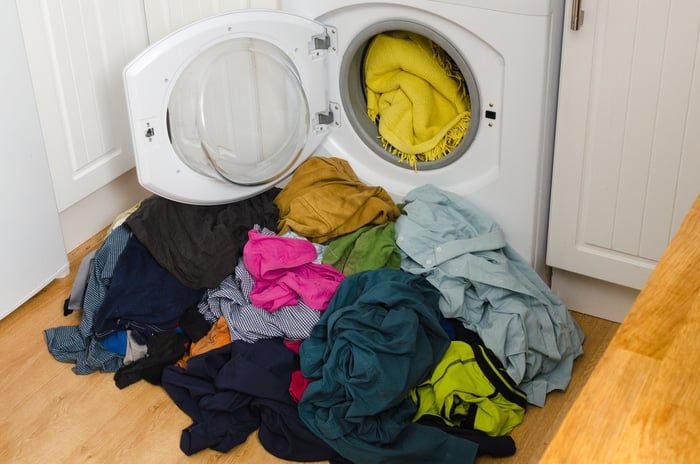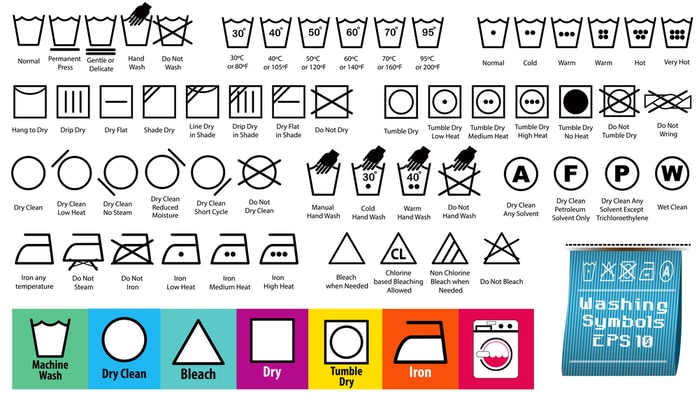Are your clothes getting tangled in your washer?
I’ve been there too! Spending time detangling your laundry can be super annoying, especially when you’re in a hurry.
Luckily, you’ve come to the right place to fix the problem.
If your clothes are getting tangled in your washer, the unit is probably overloaded, you’ve selected the wrong cycle, or you haven’t sorted your laundry. A faulty agitator or damper could also explain the tangling issue.
Read on to keep your clothes from tangling!
Clothes Tangling In Your Washer? 5 Fixes to Try
In this section, I’ll guide you through the different reasons that can explain your washer’s tangling issue and provide various solutions.
Are you ready? Let’s dive in!
#1 Avoid Overloading Your Washer
When fixing a washer that is getting the clothes tangled, I always check the size of the load.
If you overload your washer, the clothes won’t have enough space to move around. As a result, they’ll get tangled.

Keep in mind that overloading your washer can also increase the strain on the drum and shorten the unit’s lifespan. If the drum doesn’t rotate properly, clothes can get twisted and tangled around each other.
Please aim to fill about 3/4 of the drum. The clothes should be able to move freely to ensure the best cleaning results and solve the tangling problem.
I also recommend checking the manufacturer’s manual, as it typically indicates the maximum weight of clothes your washer can handle. It also provides different maintenance tips and ways to avoid stuffing clothes into the drum.
#2 Select the Right Cycle
I find that when clothes get tangled in washers, it’s typically because the wrong cycle is selected.
You see, washing machines allow you to choose the soil level, load size, temperature, fabric type, and other custom programs. All cycles have different levels of spin speed and agitation.
So, if you choose an intense cycle for delicate fabrics, your clothes will wrap around each other and get damaged due to the high spin speed.
The easiest way to prevent the tangling problem from happening again is by reading the clothing care labels and choosing the right cycle. For example, if you’re washing silk, the label will indicate that you need to select a delicate cycle or adjust the settings to lower the agitation intensity, choose a slower spin speed, and use cold water.

#3 Sort Laundry
While selecting the right cycle can help you solve your washer’s tangling issue, it’s also crucial to sort your laundry.
Avoid mixing heavy fabrics like jeans and towels with delicate clothes. Otherwise, the bulkier items can get caught on the delicate ones.
You should only wash similar fabrics together. It’s also important to take a little extra time to put your delicate clothes in mesh laundry bags to preserve their shape and prevent holes and tangles. Don’t forget to close zippers, tie up straps, and fasten any buttons.
#4 Check Your Agitator
If you have a top-loading washing machine and your clothes are getting tangled, you’ll need to inspect the agitator.
The agitator features a central post with paddles that move back and forth to dislodge dirt from your clothes effectively. Unfortunately, if the agitator is broken, clothes can get wrapped around.
A broken agitator can also lead to unbalanced loads and inconsistent spinning speed, resulting in a tangling problem.
To fix the issue, I usually advise looking through the glass lid and seeing if the agitator is moving the clothes evenly. If your washer doesn’t have a glass lid, unplug the machine and manually rotate the agitator to see if it moves smoothly. Any resistance could indicate an issue.
Note: If your agitator is broken, you’ll probably hear a grinding noise and notice your clothes haven’t been washed properly.
If your agitator is broken or damaged, please find your washer’s model number and order a replacement part.
If you want to get any replacement part – or see how much one would cost – click to enter your model number in the search bar below. Our partners at AppliancePartsPros stock almost every part with free guides on how to install them.

While fixing an agitator is a straightforward task, I also recommend checking the warranty status of your washing machine. If it’s still under warranty, you can call a professional and do the repair for free!
#5 Examine the Dampers
If you’ve tried all of the fixes above, but your clothes are still getting tangled in your washing machine, it’s time to examine the dampers.
The dampers, also known as “shock absorbers“, are responsible for moderating the drum’s vibration. They keep your washer stable and balanced.
Unfortunately, if your washer’s dampers are not working correctly, the drum will wobble too much, make a lot of noise, and cause your clothes to get tangled.
Please read the manufacturer’s manual to locate and access the shock absorbers. Look for any signs of visible damage and replace them if necessary.
If you notice your washer’s dampers are damaged, addressing the issue as soon as possible is crucial since they can cause premature wear.
Note: If you don’t feel confident making repairs, you should call an appliance expert. Otherwise, you’ll risk damaging other internal components and affecting your washer’s performance.
Wrapping Up: Your Guide to Tangle-Free Clothes
Hopefully, now you know how to fix your washing machine’s tangling problems.
Remember that if your clothes are getting tangled in your washer, you’ll need to check the load. Please avoid overloading the drum and sort your laundry. Do not mix heavy items with delicate clothing, and use mesh bags if necessary.
Don’t forget to read the fabric care label on your clothes and choose the right cycle. If the issue persists, examine your agitator and dampers. Replace any components if necessary.
Thank you so much for taking the time to read this article. If you ever experience a different issue with your washing machine or any other appliance, please check out our site. We love helping homeowners fix all sorts of appliances.
Good luck!









